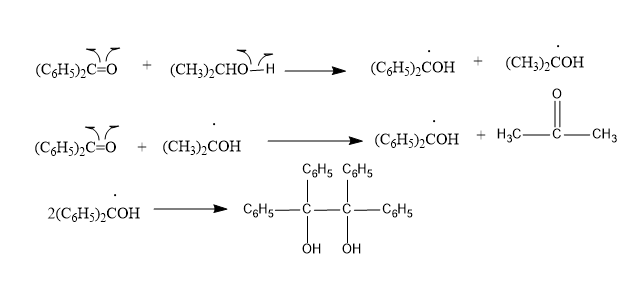
Concept explainers
Interpretation:
The benzophenone n-Π* triplet T1 without having benzophenone pass through its first singlet stateneeds to be determined.
Concept Introduction:
In the singlet state; the orientation of electrons has the same spin while in the triplet state; the orientation of electrons has the opposite spin.
Explanation of Solution
The reaction between benzophenone and isopropyl alcohol is shown below:

The quantum yield for the given reaction is a unity which states that each molecule of excited benzophenone gives one molecule of benzo pinacol. In the given reaction; fluorescence is not observed, a triplet excited state is involved. n-Π* triplet excited state takes a hydrogen atom from isopropanol.
The mechanism of the given reaction is shown below:

Where,
S0 = singlet ground state
S1 = first singlet excited state
T1 = first triplet excited state
ISC = intersystem crossing

According to the mechanism; it shows that the singlet excited state of benzophenone gores through intersystem crossing to triplet state very readily. Therefore, it is the triplet state that is involved.
Want to see more full solutions like this?
Chapter 54 Solutions
A Small Scale Approach to Organic Laboratory Techniques
- Please help me solve this reaction.arrow_forwardIndicate the products obtained by mixing 2,2-dimethylpropanal with acetaldehyde and sodium ethoxide in ethanol.arrow_forwardSynthesize 2-Ethyl-3-methyloxirane from dimethyl(propyl)sulfonium iodide using the necessary organic or inorganic reagents. Draw the structures of the compounds.arrow_forward
- Synthesize 2-Hydroxy-2-phenylacetonitrile from phenylmethanol using the necessary organic or inorganic reagents. Draw the structures of the compounds.arrow_forwardSynthesize N-Methylcyclohexylamine from cyclohexanol using the necessary organic or inorganic reagents. Draw the structures of the compounds.arrow_forwardSynthesize N-Methylcyclohexylamine from cyclohexanol using the necessary organic or inorganic reagents. Draw the structures of the compounds.arrow_forward
- If possible, please provide the formula of the compound 3,3-dimethylbut-2-enal.arrow_forwardSynthesize 1,4-dibromobenzene from acetanilide (N-phenylacetamide) using the necessary organic or inorganic reagents. Draw the structures of the compounds.arrow_forwardIndicate the products obtained by mixing (3-oxo-3-phenylpropyl)triphenylphosphonium bromide with sodium hydride.arrow_forward
- We mix N-ethyl-2-hexanamine with excess methyl iodide and followed by heating with aqueous Ag2O. Indicate the major products obtained.arrow_forwardIndicate the products obtained by mixing acetophenone with iodine and NaOH.arrow_forwardIndicate the products obtained by mixing 2-Propanone and ethyllithium and performing a subsequent acid hydrolysis.arrow_forward

 Organic ChemistryChemistryISBN:9781305580350Author:William H. Brown, Brent L. Iverson, Eric Anslyn, Christopher S. FootePublisher:Cengage Learning
Organic ChemistryChemistryISBN:9781305580350Author:William H. Brown, Brent L. Iverson, Eric Anslyn, Christopher S. FootePublisher:Cengage Learning

